Table of Contents
- Why pre-customer service matters
- Social media = the new front desk for shaping customer expectations
- Pre-sales research: meeting customer expectations early
- Real reviews = more value for the customer experience
- Platform check: where pre-sales behavior happens
- The human touch: how people engage before the sale
- Better pre-customer service = better conversion rates
- Bonus: effective strategies for improving pre-purchase customer engagement on social media + examples
- Over to you: from pre-sales to post-sales support
Most customer journeys start before the first message, often on social media.
Buyers are checking your Instagram comments and scanning reviews about your brand before they ever reach out.
That early window is your chance to build trust and guide their decision.
In this article, we share insights on what pre-customer self service looks like on social media and how to get it right, all based on data from our “From Likes To Loyalty: The Consumer Journey on Social Media” report, which you can download for free here:
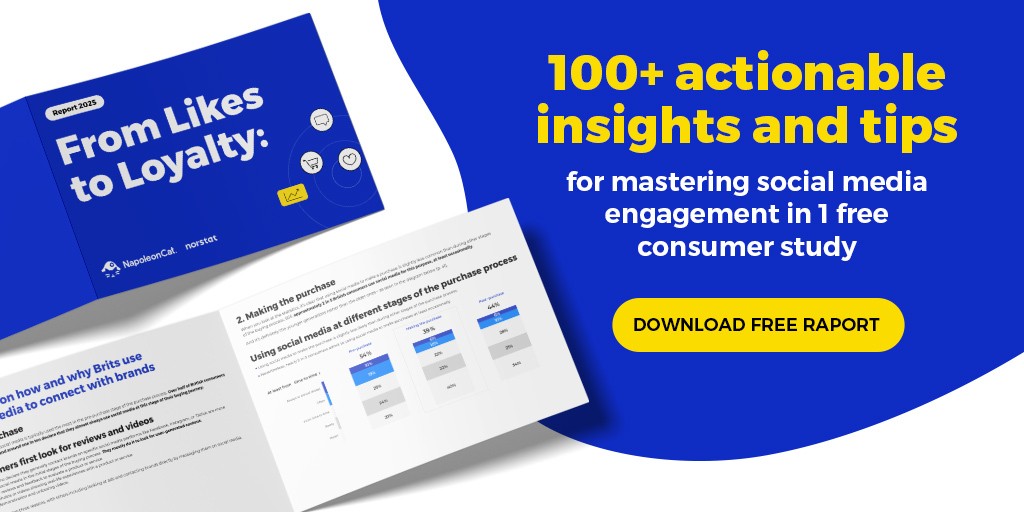
- Why pre-customer service matters
- Social media = the new front desk for shaping customer expectations
- Pre-sales research: meeting customer expectations early
- Real reviews = more value for the customer experience
- Platform check: where pre-sales behavior happens
- The human touch: how people engage before the sale
- Better pre-customer service = better conversion rates
- Bonus: effective strategies for improving pre-purchase customer engagement on social media + examples
- Over to you: from pre-sales to post-sales support
Why pre-customer service matters
Social media has become part of the sales process. Potential customers start their market research on various platforms, asking: “Is this brand legit?” “Will this solve my problem?” and “Do other people feel confident buying from this business?”
These early moments are often overlooked, but they’re high-impact.
This is where the pre-sales journey begins, and where pre-sales support plays a key role.
Responding well can build loyalty and improve customer satisfaction long before the sale, while failing to do so can end the relationship before it starts.
When you support buyers early, e.g., by addressing customer pain points and offering the right level of technical knowledge, you help them buy with confidence.
And that sets up your support teams for more sales and long-term customer success.
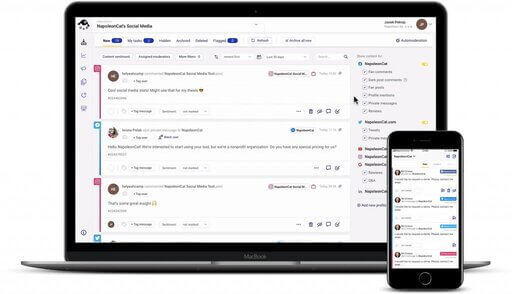
The Best Tool for Social Media Customer Support
Seamlessly manage and automate customer interactions across social media in one customizable dashboard with NapoleonCat – the all-in-one solution for Facebook, Instagram, TikTok, LinkedIn, YouTube, and more.
Social media = the new front desk for shaping customer expectations
Social media is at the forefront of creating customer expectations.
More than half of UK consumers (54%) turn to social media before buying, and 1 in 10 say it’s always part of their decision-making.
That makes platforms like Instagram, YouTube, and Facebook a key stop in the purchase decision. Nowadays, it’s where people compare options and form early opinions about your brand.
Younger buyers are leading the shift
- People aged 18 to 34 are the most active group: 75% of 18–24s and 68% of 25–34s use social media pre-purchase
- Social grades A/B are more likely to browse early (60%) than any other group
Older demographics require a different strategy
What about people aged 55 and over? Only 25% say they use social platforms at this stage. So, depending on your audience, your social media strategy may need to look very different if you want to build relationships.
Pre-sales research: meeting customer expectations early
Many customers are actively engaging with brands before they buy, asking questions or sending DMs to clarify product details.
This is where expectations are set. When someone takes the time to interact, they’re signaling intent.
What information are customers asking about?
When shoppers engage with brands during the pre-purchase phase, here’s what they want to know most:
- Availability of sizes, colors, or other variations – 47%
- Features, specs, or ingredients – 42%
- Delivery and shipping details – 41%
- Checking if the product is in stock – 40%
- Clarification on pricing and fees – 38%
These are critical customer questions that help a buyer develop a strong understanding of your brand.
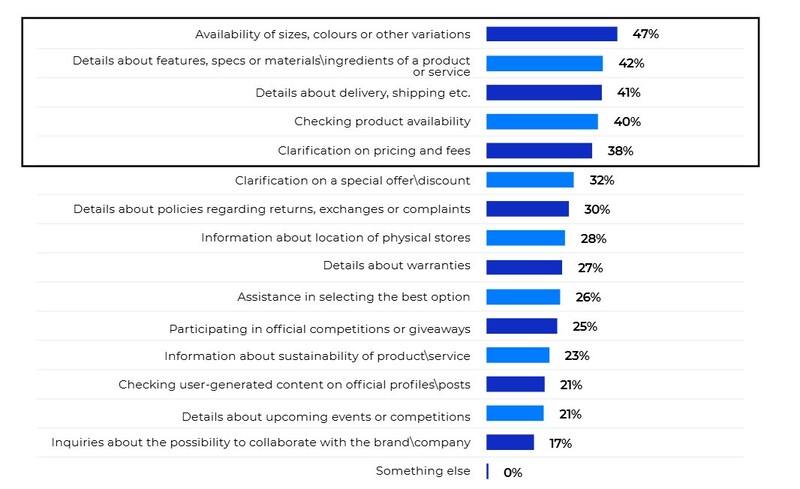
What else are they curious about?
- Clarification on a discount or special offer – 32%
- Return, exchange, or complaint policies – 30%
- Physical store locations – 28%
- Warranty details – 27%
- Help selecting the right option – 26%
And for some, it goes beyond the basics:
- Participating in giveaways – 25%
- Sustainability of the product or service – 23%
- User-generated content verification – 21%
- Upcoming events – 21%
- Collaboration opportunities – 17%
All these are buying signals.
So if your Instagram bio, FAQ post, or comment section doesn’t address these directly, you’re leaving revenue on the table.
And as Greg Berezowski from NapoleonCat puts it:
“Essentially, things that will help them decide to buy (and the absence of which can also prevent them from going through with the purchase – a solid reason not to ignore their questions.)”
Real reviews = more value for the customer experience
When we asked why people turn to social media before buying, the answer was clear: trust. Or more specifically, user-generated content, so things like real customer experiences or video demos.
What kind of content builds trust?
Here’s what they’re really looking at:
- 47% check reviews and feedback to evaluate products or services
- 43% scroll through photos or videos from real users to see real-life experiences with the product or service
- 31% watch demonstration or unboxing videos
This type of content works because it’s real. It shows the product in action, without polished scripts or marketing spin. Customers want authenticity, especially before their first purchase.
What don’t they engage with?
Start by reading your ads. Only 21% say they look at social media ads during the pre-purchase phase. Even fewer seek out influencer opinions or branded content.
Other actions that rank lower:
- 20% follow influencers to learn their opinion
- 19% message brands directly
- 17% ask for recommendations in forums or groups
- 14% leave public comments to clarify details
So, if you’re spending big on branding but skipping reviews, you’re likely missing what buyers value most.
Make space for your customers to speak and amplify their voices. Reposts, Instagram Stories with tagged mentions – this is the kind of content that builds both trust and conversion before anyone hits your site.
Platform check: where pre-sales behavior happens
Let’s discuss the platforms your buyers use in their pre-purchase journey.
Most-used platforms during the pre-sales phase
Here’s how the top platforms rank:
- Facebook – 49%
- YouTube – 45%
- Instagram – 39%
- TikTok – 25%
- X (formerly Twitter) – 18%
- LinkedIn – 13%
- Pinterest – 11%
- Reddit – 11%
- Snapchat – 8%
- Tumblr – 7%
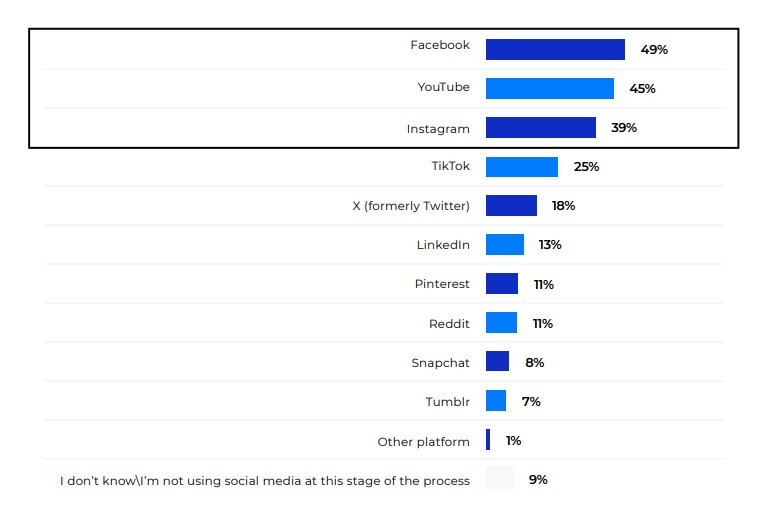
Tumblr and Snapchat rank lowest, but that doesn’t mean no one uses them. They might still matter in niche contexts.
Platform preferences by audience segment
This is where things get more interesting. Different people use different platforms depending on age, gender, and income level:
- Facebook dominates with older users, where 58% of people aged 35 to 44 and 61% of people aged 55 to 64 use it pre-purchase
- YouTube is the go-to for men: 57% vs 33% of women
- Instagram wins with women: 45% vs 33% of men
- TikTok is much more popular with users aged 18 to 24 (39%) and 25 to 34 (34%)
- Reddit, Tumblr, and X are more commonly used by men and younger users
Social grade trends
People in grades A/B use a wider variety of platforms across the board. 47% use Instagram, 50% YouTube, 52% Facebook. Meanwhile, grades D/E lean toward Facebook (51%) and YouTube (51%), with much less activity on Instagram (26%) or TikTok (21%).
So if you’re targeting higher-income groups, platform mix matters more. And if you’re speaking to Gen Z, showing up consistently on TikTok and Instagram is definitely expected.
The bottom line? One channel won’t cut it. Match your platforms to your audience and track how behaviors shift by various factors, e.g., age and gender. Because where your customers scroll is where their purchase journey starts.
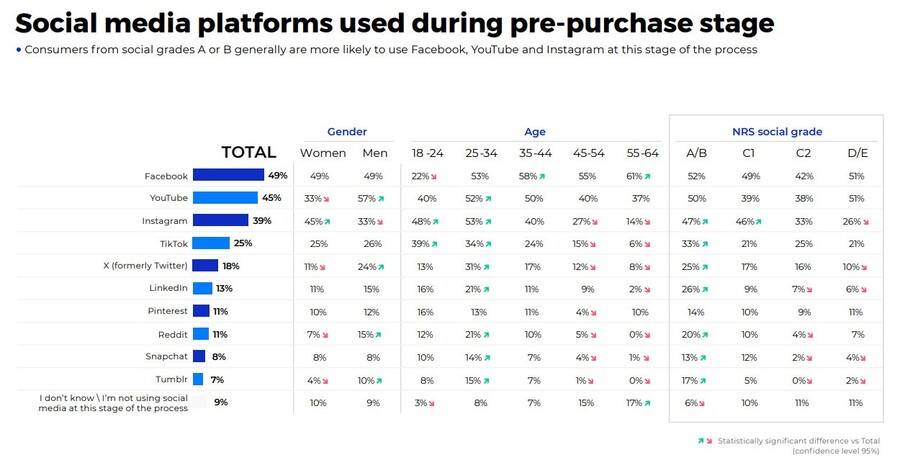
Facebook, Instagram, TikTok… Can your team keep up? NapoleonCat connects all your customer touchpoints in one place. From Instagram DMs to TikTok comments. Give your team the power to engage faster and smarter, no matter the platform.
👉 See it in action and book a live demo today.

The Best Tool for Social Media Customer Support
Seamlessly manage and automate customer interactions across social media in one customizable dashboard with NapoleonCat – the all-in-one solution for Facebook, Instagram, TikTok, LinkedIn, YouTube, and more.
The human touch: how people engage before the sale
Customers also use social media to connect directly. But the way they do it varies:
Common types of direct engagement
- 24% explore your brand’s profile
- 20% follow influencers to learn more
- 19% send DMs to brands
- 17% ask for recs in groups or forums
- 14% comment to clarify posts
Who’s most likely to reach out?
Again, people aged 25 to 34 are the most active here. They’re not shy about messaging brands or asking their network for input.
Better pre-customer service = better conversion rates
If someone’s doing their homework before they buy, and you’re not there with the info, they’ll go with the brand that is.
Your pre-customer service checklist
- Highlight real customer feedback front and center
- Make your product info easily scannable and visual
- Share demo or unboxing content from a brand ambassador regularly
- Use Stories, pinned posts, or Highlights to answer FAQs
- Monitor and respond to DMs, group mentions, and comments
Ready to support customers before they even message you? NapoleonCat helps your sales reps and support team stay one step ahead. Track comments, answer questions, and moderate DMs across platforms. All from one dashboard.
👉Start your 14-day free trial – no credit card needed.

Bonus: effective strategies for improving pre-purchase customer engagement on social media + examples
We reached out to leading UK digital marketing agencies and asked a simple question:
What really works when supporting potential customers before they buy?
Here’s what they told us:
1. Start conversations, not campaigns
“Most brands still treat social media like a megaphone when it should be a telephone,” said Jm Littman, CEO of Webheads.
When someone drops a comment, it’s a chance to build a relationship, not pitch a product (or, worse, go silent…). That moment of human interaction is where a hesitant scroller becomes a qualified lead.
👉 Tip: Train your sales reps or community managers to engage like real people, not scripts. Social platforms are the preferred channel for many, and being present here with real conversation helps generate brand loyalty and repeat business.
KFC’s social media paradox: active in posts, absent in comments
KFC UK is beloved by many and used to know how to create some buzz with playful, culturally relevant posts. For example, their “I do want a corn on the cob” campaign was perfectly timed, taps into pop culture (#GavinAndStacey), and draws plenty of attention.
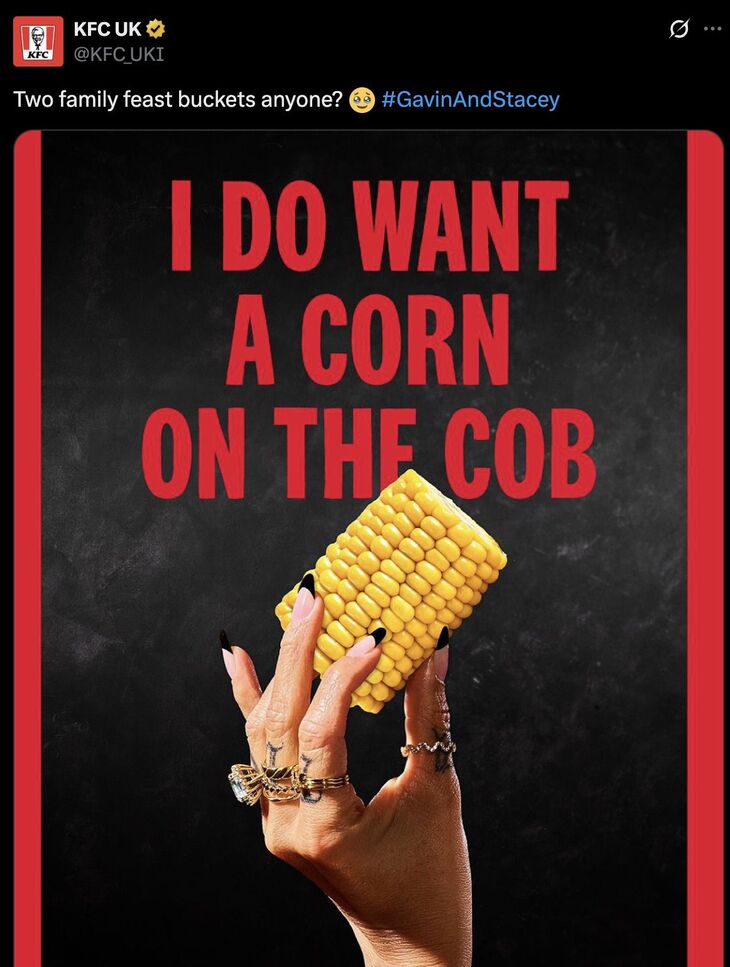
But when the audience shifts from engagement to intent, asking about availability, app functionality, or how to get help, the brand goes quiet.
Just take a look at their mentions:
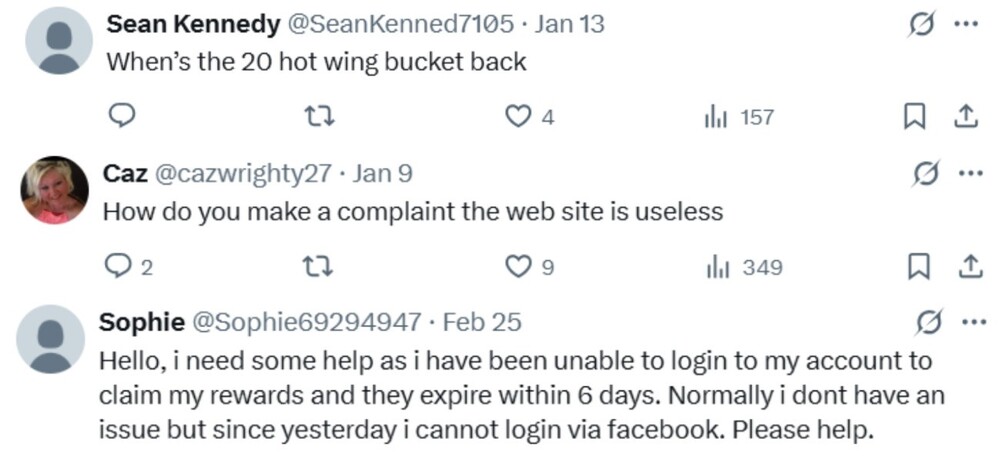
None of these tweets received a visible reply. And because they sit under older posts with no response, it leaves the impression that KFC’s social team is only tuned in when it’s time to post, not when it’s time to serve.
Takeaways:
- Engage with cultural moments → KFC excels at launching creative, on-brand campaigns that drive top-of-funnel buzz. No question there.
- Follow through when customers show intent → Pre-purchase questions (such as product availability or loyalty rewards) are key indicators of intent. Ignoring them is like ignoring someone at the counter.
- Make social media a two-way channel → Posting isn’t enough. The comment section is where decisions are made.
- Show up where expectations are highest → If you want your app to be part of the customer journey, you have to support people when it fails, especially if it’s standing between them and their next order.
2. Balance speed with substance
“It’s not a question of speed being more important than substance, or vice versa – they both need to be given the same level of priority,” said Ben Kerry from Jak HQ.
Your sales team might respond fast, but if it’s a generic answer, it falls flat. What customers expect today is quick, personalized support that feels like it was written just for them, especially during the pre-sales phase.
👉 Tip: Use smart automation for FAQs, but route product questions to real humans fast. This blend of efficiency and real-time insight supports informed decisions and can drive repeat purchases.
3. Make social media your full-funnel channel
“Brands are turning platforms into ecosystems — from discovery to conversion,” said Dan Taylor, Partner at SALT.agency.
With tools like Instagram DM automation and TikTok Shop, there’s no need to direct people off-platform. Instead, support them where they are with more value and fewer clicks.
👉 Tip: Integrate your pre-sales activities with social media commerce tools and support agents to boost conversion rates. When you use solutions that allow for seamless handover between discovery, lead generation, and closing deals, you make the decision-making process easier and your brand more memorable.
Made by Mitchell’s TikTok Shop: from scroll to sale, no detour needed
Made by Mitchell, the UK-based beauty brand founded by MUA Mitchell Halliday, has turned TikTok Shop into a full-funnel experience that blends product discovery with community engagement and purchase in one loop.
A recent livestream is a textbook example: real-time product demos, comment interaction, secret discounts, and on-the-spot purchasing. All without ever leaving the app.
“Stay in the live to see the secret discount code revealed” reads a bubble on screen, while vibrant packaging and enthusiastic hosts create an experience that feels more like a backstage pass than a sales pitch.
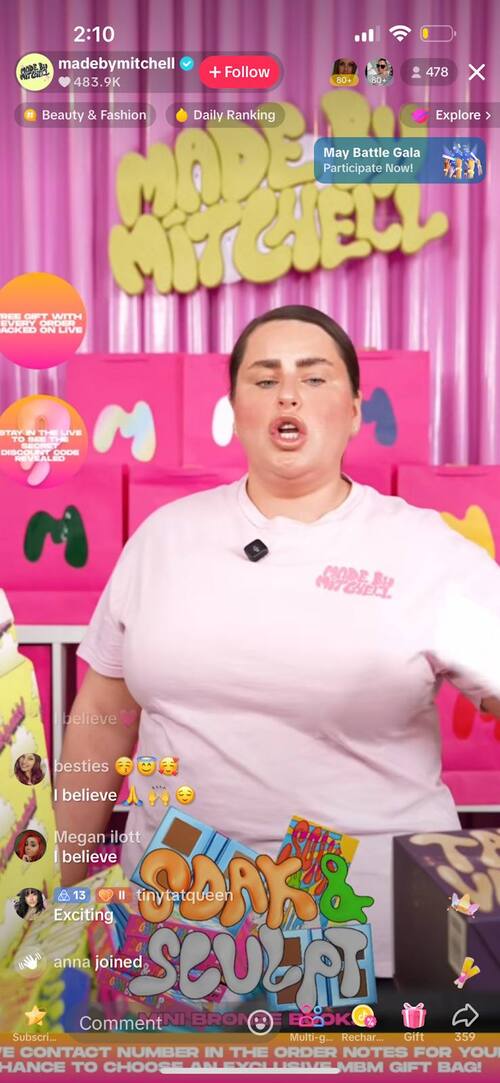
Takeaways:
- Create urgency with live incentives → Viewers are encouraged to stay for exclusive perks, like a free gift with every order and limited-time discounts only shared during the live. It’s classic scarcity, but repackaged for the TikTok generation.
- Engage in real time → The team doesn’t just present products – they also shout out usernames, and answer questions on the fly. It’s proactive support that builds loyalty and helps buyers feel confident in their choices.
- Bridge discovery and purchase → No “link in bio,” no redirect. TikTok Shop lets viewers buy the product they’re watching in seconds.
- Reinforce brand identity through experience → From the signature hot pink packaging to a host in branded gear, everything is recognizably “Made by Mitchell.”
4. Spot and act on buying signals
“When someone asks about sizing or shipping, they’re a warm lead — yet they’re often ignored or answered with generic replies,” warned Tom Jauncey, Head Nerd at Nautilus Marketing.
These are pre-sales conversations, not customer service tickets. They’re your best shot at building customer loyalty before the initial purchase even happens.
👉 Tip: Treat every product question as a high-value customer interaction, not an interruption. Empower your sales representatives with the product knowledge to provide honest advice that helps customers engage with confidence.
5. Build answer squads, not bots
“One major challenge is sounding transactional,” said James Owen, Co-Founder of Click Intelligence. “Instead, use ‘answer squads’ — social-savvy staff who reply in under 10 minutes with a helpful, natural tone.”
This creates trust and helps you stand out in a feed full of scripted replies.
👉 Tip: Give your sales professionals the freedom to speak like humans, not templates. When your team offers helpful, real answers that align with your brand values, you build long-term credibility and achieve success without raising ethical concerns.
Greggs UK: answering the real questions before the first bite
Pre-purchase questions aren’t always about discounts or delivery. Sometimes they’re about health and safety. One customer, Ellie, tweeted at Greggs UK asking where to find garlic-free menu options without having to “trawl through the entire menu.”
Greggs replied with a short, polite ask: “please can you drop us a DM?”

That’s it. No redirect. No allergen link. Just a fast, human response that says: we’ll handle this personally.
Takeaways:
- They responded quickly → The reply came within the same day. It’s a small but important signal to the customer that their concern was noticed and mattered.
- They kept the tone friendly and direct → No canned apology or jargon. Just a natural request for a DM that invites conversation, not friction.
- They prioritized privacy and clarity → Allergen-related questions are high-stakes. Instead of offering a vague resource or default PDF, Greggs offered 1:1 support – the kind of interaction that builds real confidence before a purchase.
- They turned a potential blocker into a trust-builder → What could’ve been a frustrating user experience (“where’s this info?”) became a moment of proactive support. That’s how loyalty starts – before someone even walks into a shop.
And here’s the main takeaway: Pre-purchase engagement is no longer a cost center. It’s a strategic driver of revenue. When done well, it leads to positive reviews and the kind of trust that keeps people coming back.
Over to you: from pre-sales to post-sales support
Being helpful starts when someone finds your post while deciding between you and someone else.
So, before you focus on “reactive” support, think about all the little moments that happen earlier.
Because that’s where trust is built and where social media becomes the first (and sometimes only) line of customer service.
And if you want to stay ahead of those moments, leverage tools like NapoleonCat. Get ready to track comments, moderate DMs to answer product questions, and hand off leads. Start now – completely for free.

The Best Tool for Social Media Customer Support
Seamlessly manage and automate customer interactions across social media in one customizable dashboard with NapoleonCat – the all-in-one solution for Facebook, Instagram, TikTok, LinkedIn, YouTube, and more.
You may also like:
- Top 11 Customer Service Tools for a Successful Year
- Master Post-Purchase Customer Support on Social Media
- How to Handle Difficult Customers on Facebook
- How to Boost Customer Service with Instagram DM Automation
- The Best Social Media Crisis Management Tool
- Customer Experience Management: What It Is and Which Tools to Use
- How to Use Automated Customer Service on Social Media
- How to Maximize Customer Retention With Social Media
- AI vs Human Responses on Social Media: Facts & Figures


